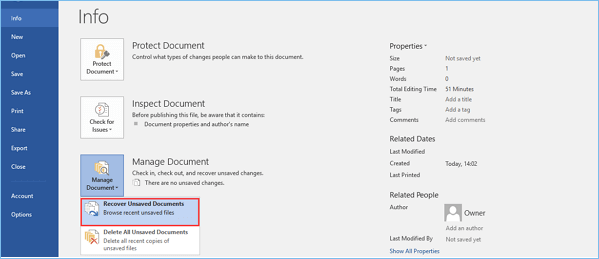

- Microsoft word 2016 for mac closed without saving how to#
- Microsoft word 2016 for mac closed without saving Pc#
Once it's opened, go to the drop down menu again and select "Save As" and select file format drop down again and select the Reopen Word and in the drop down menu select "Open Recent." Select the document you just saved. It will save your document in Compatibility Change the file format to Word 97-2004 (.doc) Click save. I found a way to work around it for now until they fix this bug.Ĭlick on the drop down menu and select "Save As." Then look for the File Format box in the lower right hand corner of the Save As box you should be in. The other and was afraid I changed some settings in the process without knowing? I Has anyone had the problem after working in I-Cloud? Could the I-Cloud settings have made some universal change? I had dragged things into i-cloud to try to get them to transfer from one drive to

I thought it was just my set up because I am trying to migrate documents on a Seagate drive that was not ex-fat formatted and the issue there on the MAC is that it opens only a Read Only copy of anything saved on an external drive It also shows the message that docx is the xml-based format that is used and it "cannot store VBA macro code." It hasīeen going on all week. Will not do the "Save As" and it states at the bottom the "recommend compatibility issues" check.

The SAME drive will open Word Documents on the MAC and save the changes but it
Microsoft word 2016 for mac closed without saving Pc#
We recommend keeping the other two options at their default settings, unless you have a good reason to change them.Īnd that’s about it! The Office recovery feature won’t save you from every kind of mishap you might run into with your files, but it can sure come in handy during those occasional moments of panic.I have tried opening my Word documents on the PC from an external drive formatted with the ex-fat file formatting and those documents can "Save As" on the PC. We’ve found that the background saving doesn’t really interrupt anything, so usually set it down to around two minutes. You can set it to autosave anywhere from every one minute to every 120 minutes. If autosaving every 10 minutes seems like too long an interval (it does to us), bump that setting down to whatever you want. The top few options are what you’re looking for. On the Options page, click Save and then look for the “Save Documents” section. You can also change how each Office application saves these temporary files, including where the files are saved, how often they’re saved, and whether a temporary file is kept if you close a document without saving. Change How Office Applications Automatically Save Files Office applications automatically save temporary backups of files at periodic intervals (every 10 minutes, by default), so your file should contain most of the work you lost. Select the file you need and then click Open. The UnsavedFiles folder contains all unsaved files Office has created temporary backups for. On the Info page, click “Manage Document” and then, from the drop-down menu, choose “Recover Unsaved Documents.” Note also that you have an option for deleting all unsaved documents should you want to do that. Start by opening whatever Office application you were working in where your file didn’t get saved. You might just have to hunt around a bit for the actual commands. Also, the recovery feature has been around for a long time, so if you’re using an older version of Office (going back to at least Office 2007), you’ll still be able to attempt recovery.
Microsoft word 2016 for mac closed without saving how to#
RELATED: Why Deleted Files Can Be Recovered, and How You Can Prevent It How to Recover an Unsaved Office Fileįor these instructions, we’re working in Word 2016, but the steps are almost identical in other Office 2016 applications like Excel and PowerPoint. That said, if you do run into a problem with an unsaved Office file, here’s how to recover it. Back up your computer regularly and consider turning on the file version feature in in Windows. Also, you’d be well served to put some additional preventative measures in place before you actually run into this problem. We’re not talking here about when you’ve actually deleted a file in Windows, though there are ways you might recover from that kind of mishap as well.


 0 kommentar(er)
0 kommentar(er)
